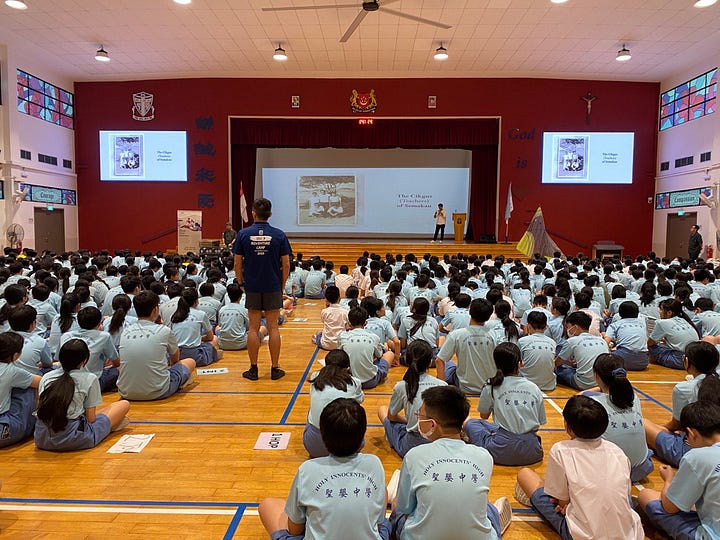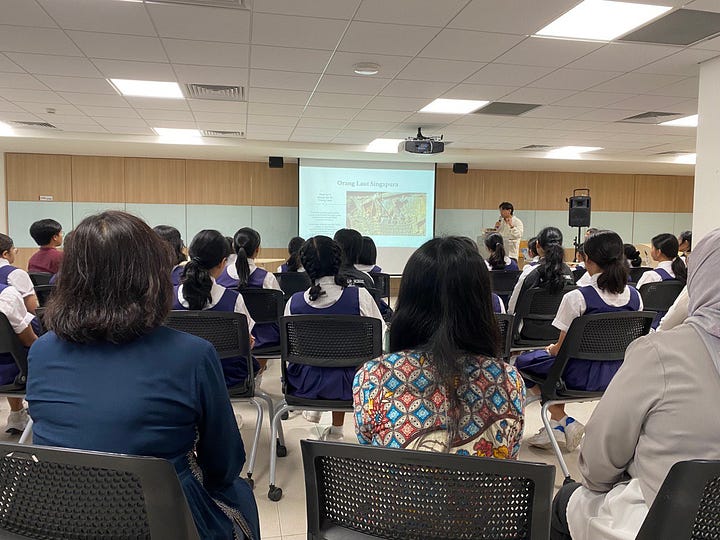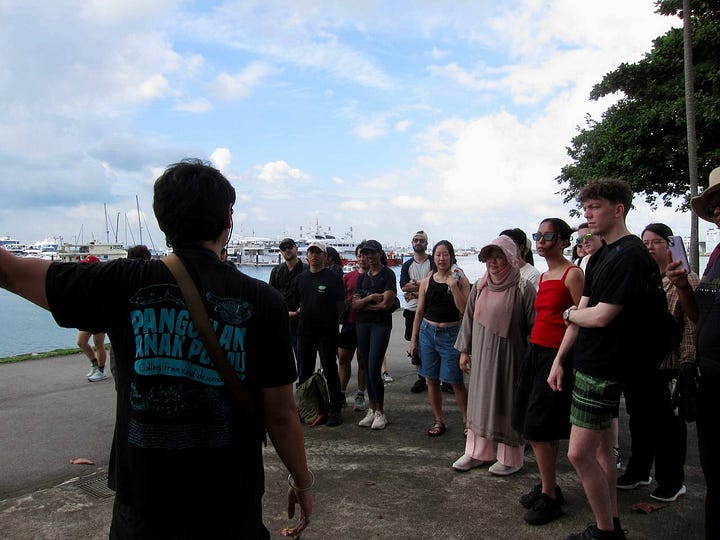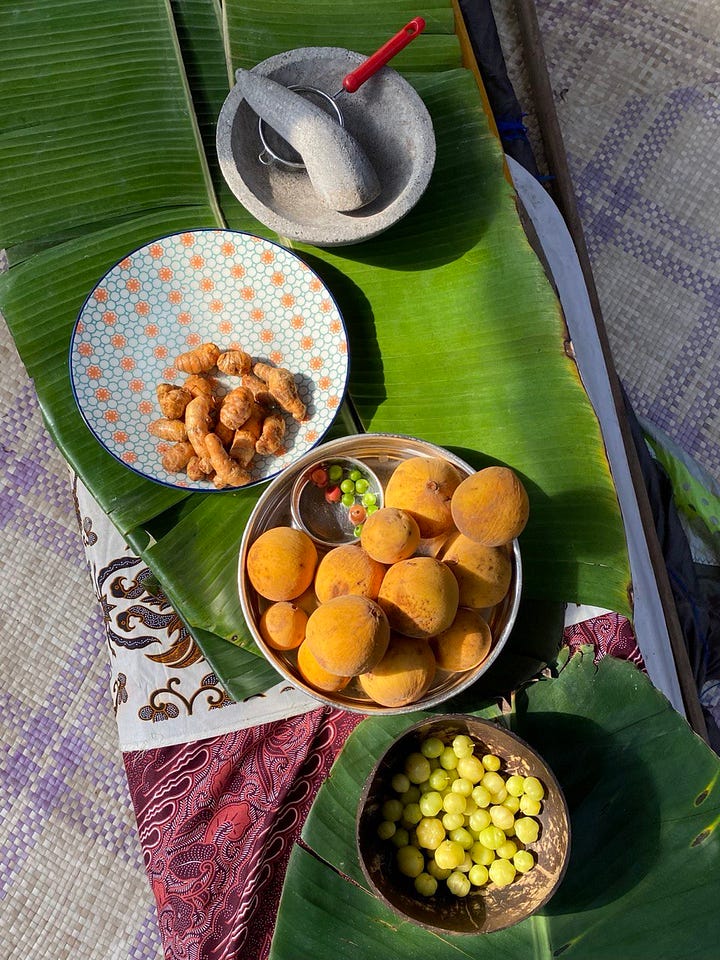When did Indigeneity become so contentious?
Reflections on identity and migration from centuries before Raffles
In one of the oldest written accounts believed to reference Singapore, a 3rd-century Chinese traveller described the island as Pu-luo-zhong, thought to be a transliteration of Pulau Ujong (“island at the end of a peninsula”). This name, used by the Orang Laut who sailed the Nusantara, hints at a deeper history of Singapore — one that is often overshadowed by more dominant narratives. Both Malay and European historical texts describe the vital role that the Orang Laut played in navigation, trade, and development of the region; by the 14th century, they had developed strong ties to the Malay rulers of that period, serving as their orang kerahan (nobility’s vassals) and performing kerahan (traditional or corvée services).
If you follow us on Instagram, you might recall a reel we posted in January, where we had the privilege of speaking with anthropologist Dr Vivienne Wee. She shared valuable insights on this vibrant history and the idea of indigeneity in Singapore—something we’ve been reflecting on deeply: What does indigeneity mean in the context of Singapore? Who does it include? And do we have the rights to use this term?
By definition, Indigenous communities are descended from the earliest known inhabitants of a place, especially one that was later colonised. Indigeneity is not always tagged to land, but rather rootedness in a specific place, including river or seascapes. In Singapore, the Orang Laut are recognised by researchers as Indigenous “people of the sea”, while Malays as an ethnic group are considered Indigenous to the wider Nusantara. When Raffles arrived in 1819, there were several suku-suku (groups) of Orang Laut living in Singapore, including the Orang Biduanda Kallang, Orang Gelam, Orang Seletar, and the Orang Selat. Historical records typically describe these groups as distinct from smaller communities of Malays and early Chinese immigrants.
But indigeneity isn’t just about being the “earliest inhabitants”. It also speaks to rich, enduring connections with the land and sea— ways of life shaped by, and shaping, the environment for centuries. In a webinar hosted by RIMA, Dr Vivienne Wee explained that Maritime Southeast Asia only emerged as we know it today when the sea levels rose thousands of years ago. Before that, Singapore was part of a larger landmass known as Sundaland.
Amid this shifting geography, the Orang Laut came to prominence with their unmatched knowledge of the seas and its numerous islands, islets, and shoals. Their expertise in navigating these waters was indispensable to trade and travel in the region, which was known for being treacherous to foreign sailors.

After some of the Orang Laut, such as the Orang Selat, settled on the islands surrounding Singapore, coming to be known as Orang Pulau, they continued to nurture cultural beliefs and practices that reflect an intimate relationship with the environment. Certain animistic beliefs stem from a reverence for nature; for instance, there are sacred spaces on the various Southern Islands, like a tree on one of the Southern islands thought to be a sacred portal. When fishing or foraging, it is a core principle to only take what is needed, ensuring balance with the environment. Today, former islanders and descendants who still go out to sea carry an inherited knowledge of these waters.
Globally, similar worldviews are expressed by other Indigenous peoples. Increasingly, there is recognition that Indigenous knowledge systems – built on reciprocity, adaptability, and respect for the natural world – hold great wisdom, especially in discussions on sustainability and environmental change. As Potawatomi writer Robin Wall Kimmerer explains,
At Orang Laut SG, we embrace the term “Indigenous” to honour the deep, living connections that these communities maintain with the surrounding land and waters. It is also a rejection of colonial-era terms like “early migrants” or “settlers”, which downplay both these long-standing ties and the impacts of displacement and urban development. Acknowledging indigeneity affirms the Orang Laut’s place in Singapore's heritage, their historical role in the region, and the losses that came with relocation.
Upon sharing our Instagram reel of our conversation with Dr Vivienne, we were moved by the outpouring of solidarity and support. Many people commented on the lack of dialogue around pre-colonial history in Singapore, and other descendants reached out, relating to the stories and places Dr Vivienne brought up. The response reinforced how much these narratives matter—and how important it is to continue creating spaces for them.
In just four months, we will be holding Hari Orang Pulau, a day-long festival celebrating the culture, heritage, and stories of Singapore’s islander community, including descendants of the Indigenous Orang Laut. If you’ve ever contemplated the idea of indigeneity in Singapore, or how we can better understand our island’s identity and the diverse coastal communities that shape it, we’d love for you to be part of the conversation. Come share, learn, and celebrate with us — on 14 June 2025, West Coast Park. As a ground-up initiative, any and all contributions also go a long way in bringing this festival to life. We are still working hard to meet our fundraising goals!
We’re grateful for the opportunities we’ve had to explore similar themes with some of you through our recent events. Here’s a little recap of what we got up to in February!
We started the month with a talk at Raffles Girls’ School (Secondary) as part of their Mother Tongue Language fortnight, and a sharing session for the Secondary 1 and 2 cohorts at Holy Innocents’ High School. Thank you for having us! It’s always a joy to share stories with students and spark conversations about Singapore’s island heritage, and we’d love to continue these exchanges with more educators and schools.


At Tanah dan Air, we hosted Isi Nio, the third of our Nio Series. Dr Anthony Medrano took us on a deep dive into the cultural and culinary significance of the coconut in the Nusantara, while culinary content creator Azfar Maswan explored traditional ways of using the coconut’s various parts. Azfar led a cooking demonstration of coconut-based dishes like Javanese urap, flavoured by ingredients lovingly “ulek-ed” (hand-ground) by our participants. Cik Nooraini and Cik Rohaini, former islanders from Pulau Semakau, shared a special dish of gamat (sea cucumber) topped with kerisik (toasted, grated coconut), bringing a taste of the islands to the table (and tikar).
Last week, we welcomed two lovely groups for our Coastal Walk, Food & Stories sessions. Together, we strolled through West Coast Park, sharing stories of the Southern Islanders, explored the community space, and set up the jong (traditional miniature sailboat) along the coast. Over a shared meal of Southern Islander cuisine, we also got to taste local fruits traditionally foraged by the Orang Laut / Pulau, such as buah sentul and buah cermai. A huge thank you to everyone who has visited our garden and made it feel like a home – our hearts are always warmed by your presence.




On 1 March, we are running a special tour at West Coast Park in collaboration with the National Museum of Singapore, as part of their Amazônia exhibition. The exhibition features stunning images by Sebastião Salgado, offering a glimpse into the lives of Indigenous communities in the Amazon. If you’d like to join us, tickets are available but going fast - get yours here!
Later in the month, we’re also planning to organise our annual Bubur Lambuk Ikan Tenggiri (spiced mackerel porridge) distribution and host an Iftar night for our volunteers. All are welcome – keep an eye on our Instagram and Telegram group for updates.
As always, thank you for being part of this journey with us, and Ramadan Kareem to all our Muslim friends :) Stay safe!
Firdaus










Dear Firdaus,
We had difficulty reaching you via email so we decided to leave a comment on your Substack. Hello! We are from the Young Asians Foundation (https://www.youngasians.org). We are a youth-led, non-profit organisation that accelerates Asian youth to become the next generation of young Asian disruptors. At the YA, we run a 6-week virtual accelerator and a 4D4N physical summit for the selected fellows. We’re funded and backed by Emergent Ventures. More relevant information can be found at our website.
We love what you’re doing in preserving and celebrating the Orang Laut heritage. You’re truly a disruptor in your field! That’s why we are inviting you to join the 100 individuals in the YA100. In the YA100, you’ll be a mentor for a few youth participants that look up to virtuosos and visionaries like yourself.
What is the YA100?
The YA100 is a list of 100 high achieving and trailblazing young individuals from Asia like yourself who come from all walks of life. They are talented STEM researchers from colleges like MIT and Harvard, founders of startups and service projects that touched the lives of the community around them and creative artists sharing their work region-wide and worldwide.
You can check out some of the current YA100 mentors at https://www.youngasians.org/ya100. The YA100 include:
1. Bai Ruotong, Undergraduate at Princeton University, Represented Singapore at the Research Science Institute held at MIT, Represented Singapore at ISEF 2023
2. Medha Shridharan, Undergraduate at Stanford University, Published a Paper in IRC Conference Science, Engineering and Technology (IRC-SET) 2023 at the age of 18
3. Armaan Dhanda, Founder of Pawsible, S&T Scholar at NUS and Bioengineer at Anthology based in Boston, Massachusetts
4. Jamie Wen, Founder of the Asian Youth Research Journal and Represented Singapore at the International Science and Engineering Fair (ISEF), placing 3rd place
5. Judy Chua, Founder of PeacePod and Student Leader
6. Shayna Leng, Undergraduate at Harvard University and former Team Singapore Debater
7. Gena Soh, Co-Founder of Playces, Philosophy Graduate from Yale-NUS and Changemaker at Give Asia
8. Kah Shuen Gan, CEO of Handishelf, Represented Singapore at the Research Science Institute held at MIT and Team Singapore Dancer
9. Jamie Yau, COO at Cyber Youth Singapore and National Young Leaders Fellow
10. Ray Wehn, Undergraduate at Singapore Management University, Founder of CORDY Singapore
11. Dr. Tommie Chen, PhD in computational linguistics, Head of Partnerships, Partnership & Market Development Division at the Institute for Adult Learning, Singapore University of Social Sciences (SUSS)
As part of the YA100, you will personally mentor 2-3 young talents working on projects of similar focus to your own achievements for a span of 6 weeks (only two 30 min meetings minimum). You’ll provide valuable insights to accelerate their endeavours and develop the next generation of trailblazers.
What’s in it for YOU?
- As part of the YA100, you and your achievements will be shared on our social media and press releases (if you’d like). This programme is not only about the participants, but it's also about spotlighting the amazing work you’ve done.
- You will be invited as a distinguished guest to our YA physical summit. This event is a 4D4N event held in Singapore (optional for you) for the youths in the programme to come together for excursion, network with like minded individuals, and present their endeavours to the rest of the congregation (if you come, you can help judge and evaluate their work).
- You will get to empower and accelerate young talent who you were once like!
- We will show our appreciation of your time and commitment by issuing a token of recognition of your efforts towards this cause
What You’ll Do:
As a YA100 mentor, you will be added into a communication group with your matched youths/groups and you will help to answer their queries and give them feedback as they work on their Endeavour over 6 weeks.
Minimally, you will have at least two 30 min calls with each youth/group across the span of 6 weeks (according to your availability). You are welcome to go beyond and help these teens 10x their impact and work, perhaps by connecting them to people, holding more calls as you see fit and sharing resources.
Next Steps:
Our journeys to success often rely upon key mentors and experts guiding us and being there for us. We hope you could now take on that role in mentoring young talent in Asia and join the YA100!
If you’d like to join us, please email us at team@youngasians.org and we’ll discuss further from there. See you!
Regards,
Team @ Young Asians Foundation